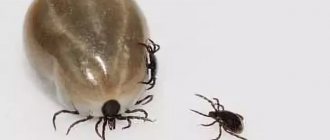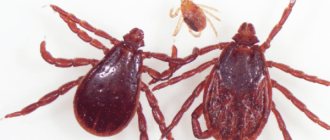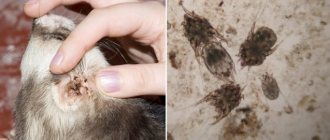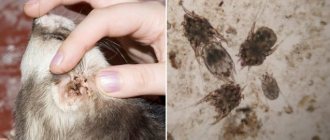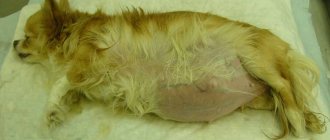In the summer, ticks become more active, which poses a danger to the health of pets. A dog can pick up an insect, since these bloodsuckers are found in grass and trees. With their paws they cling to the fur, after which they easily reach the skin.
It is important to know how to remove a tick from a dog, because with their saliva these insects secrete Babesia, which destroys red blood cells. The liver does not have time to remove the breakdown products of red blood cells, and the kidneys take over this function. Without treatment, the animal dies from oxygen starvation and intoxication.
The tick must be removed within a few hours, otherwise the dog will inevitably become infected. You need to figure out how to properly remove the bloodsucker from the skin. Every owner should become familiar with the consequences of a bite.
Danger of ticks
To properly respond when your pet is attacked by a tick, you need to know some facts about them:
- Ticks go through four stages in their development. Only adults are dangerous for dogs. A nymph may still cling to the puppies.
- In an adult, the head (or rather the cephalothorax) is clearly separated from the abdomen and there are 4 pairs of legs. Nymph - looks like an adult, but has 3 pairs of limbs. If the parasite has already attached itself and drank blood, in appearance it will resemble a large dark mole.
- A hungry tick is brown in color, and when it drinks blood, it acquires a light shade and becomes closer to gray.
- In Russia, the two most common types of ixodid ticks that can be dangerous are the dog tick and the taiga tick. Despite the name “dog” tick, it clings to many species of animals and humans.
The main danger is not the ticks themselves, but the even smaller parasites they carry.
The most common of them:
- Ehrlichia canis - microorganisms that cause ehrlichiosis
- Borrelia burgdorferi is the bacterium that causes canine borreliosis, also known as Lyme disease.
- Babesia canis is a blood parasite (it penetrates red blood cells and destroys them), causing canine pyroplasmosis, or, another name, canine babesiosis.
You will not be able to know for sure whether your pet has been infected or not unless you have the parasite itself tested. In the worst case scenario, until the pet begins to show signs of illness, which may occur in a few weeks.
A tick can become infected through a bite (although the process is more like an injection). He injects his saliva into the bite site, which, in addition to a special substance (painkiller), may contain dangerous microorganisms.
Tick suction occurs as follows:
- with parts of the oral apparatus it cuts the skin and pushes its proboscis there;
- on the proboscis there are several teeth with which the tick is firmly held in the skin; it looks like a saw.
When to examine your dog
While walking or actively playing in the grass, a dog can easily pick up a tick. In order to avoid unpleasant consequences, the animal must be examined. It is best to do this several times during a walk after active games, before going home, and also when you have already entered the apartment and are wiping the dog’s paws. This increases your chances of finding a tick before it bites your pet.
While walking the dog during a period of increased tick activity, I examined Bormann every time he got tired of running and came up to me. Almost every time he brought a bloodsucker on his fur. It is easier for owners of light-colored dogs to detect the pest, but those whose pets have dark hair have to be extremely careful.
Diseases and symptoms
As already noted, a tick bite can cause serious diseases, the most dangerous of which are:
Piroplasmosis or babesiosis
The most common disease, dangerous for dogs of all breeds and ages. The incubation period is up to two weeks. Symptoms:
- lethargy;
- temperature increase;
- refusal to eat;
- thirst;
- mild jaundice - the mucous membranes become pale, with a yellowish tint;
- at the peak of the disease, the urine becomes dark, sometimes with a red tint;
- diarrhea, yellowish or greenish stool color;
- vomit.
Borreliosis or Lyme Disease
An infectious disease that can affect all systems of the body, because of this, the symptoms in each individual case are very different. The appearance of any symptoms may begin several months after infection!
Ehrlichiosis
An infection that affects several body systems at the same time. The incubation period ranges from several weeks to several years. This disease knows how to wait. First warning signs:
- poor appetite;
- elevated temperature;
- depressed state;
- reluctance to play;
- sudden weight loss;
- vomit;
- diarrhea;
- bruising on the mucous membranes and skin.
None of these diseases can be waited out or cured at home; at the first suspicion, immediately contact a veterinarian!
What to do with a removed tick
Throwing out a parasite is reckless, and squeezing is useless. Collected ticks are burned along with a piece of cloth, napkin or cloth, if they were purposefully collected on the territory. When an insect is removed from human skin, it is recommended that the individual be sent to a laboratory. This will make it possible to accurately determine whether she is a carrier of a dangerous disease and which one. Information is necessary for further monitoring of well-being and tracking the most striking symptoms during the period of possible incubation, since treatment is effective precisely at the first manifestations of the disease.
For preventive purposes, immunoglobulin or doxycycline is prescribed. The doctor makes the appointment, he also writes the prescription and observes the patient. If the study shows that the tick is not a carrier of any pathogen, then emergency chemoprophylaxis is not carried out.
Before the spring season, it is worth purchasing a device in advance for the safe removal of ticks and meeting a possible aggressor in full combat readiness.
How to look for ticks on a dog
It is worth examining your pet after every walk. Pay special attention to areas of the body where there is the least hair and it is not long:
- muzzle, especially nose;
- ears, both outside and inside;
- paws. Many people forget to examine the pads and between the toes;
- stomach;
- groin area.
After examining the parasite’s “favorite” places, inspect the neck and back.
Carefully examine each area of the body, parting the fur. Buy a brush - it will be much more convenient for your dog to use a comb.
This routine procedure of examining your dog from the tip of his nose to the tip of his tail can save your pet's life. After all, this is the only way to detect a tick in time, do not neglect it.
How to examine an animal
The Ixodid tick is relatively large. In a hungry state, its body length can be 2 mm. After sucking blood, it increases in size and can reach 1.5 cm.
The main weapon of the ectoparasite is the proboscis, which consists of upper and lower jaws, a base and a pair of tentacles. The upper jaws cut the skin, the lower jaws are used for fastening.
It is believed that ticks fall from tree branches. But it is wrong. The bulk of ectoparasites are located closer to the ground, on grass, both fresh and dry. There are many of them in the forest, especially dense ones, near a river, in a meadow. They do not climb to a height of more than 1.5 meters above the ground.
When a tick gets on the fur, it does not immediately attach itself to the skin, so there is always time for inspection. It needs to be done every half hour.
In dogs with short hair, ticks are clearly visible. Representatives of long-haired breeds are combed with a fine comb against the growth of the coat after each walk.
Already attached parasites can be identified by stroking the dog against the growth of the fur. You will feel a lump to the touch.
Algorithm for removing ticks at home
If you do not have the opportunity to get to the clinic as soon as possible, then you should act at home. To do this, you need to have a device for twisting a tick in your home medicine cabinet. This could be one of the following:
- tweezers. It is better to use with a curved tip;
- special device - twister. The best choice! Veterinary clinics resort to this method;
- thread;
- medical syringe.
Proceed according to the following algorithm:
Prepare scissors, a magnifying glass, a device that will be used to remove the tick, and a jar to close the tick (it must be delivered to the laboratory). Prepare your own gloves!
Secure your dog in a way that is comfortable for both you and him.
It is necessary to trim the hair at the site of the bite.
Further actions depend on the tool you choose.
- If you use tweezers, carefully grasp the tick as close to the head as possible, do not touch the abdomen. The main thing is not to crush the parasite during the procedure! As soon as you have fixed the tick, begin to pull it out, making rotational movements, at the same time twisting and pulling upward.
- If you have a twister, then everything is much simpler - you definitely won’t crush the parasite with it! Grab the tick from the side and pull it up. When you managed to fix it, the principle is exactly the same as with tweezers. Pull it out using a rotational motion, gently pulling the tick upward.
- The method with a thread is not a very good idea, since there is a danger of simply cutting the tick with it. Nevertheless, this is an effective method when there is no special device at hand. Make a loop of thread and use it to tighten the parasite as close to the dog's skin as possible. This way you are most likely to catch the proboscis. Once secured, pull the thread from side to side, as if loosening the little enemy, then carefully pull it out.
- The syringe method doesn't always work, but you can try. You need to close the nozzle of the syringe (without a needle!) on the parasite, so that the syringe is in close contact with the skin; for this you can even lubricate the skin around the syringe with cream. Next, simply pull the piston, creating a vacuum, and the tick will pop out on its own.
After removing the pest, look under a magnifying glass to see if its legs and proboscis are in place. This will ensure that there are no parts of the parasite left in the dog's body. Otherwise, you will have to remove the remains with a needle, or even contact a veterinarian (he will make an incision). If this is not done, inflammation may develop.
Seal the tick in a jar to take to the laboratory.
Treat the bite site with an antiseptic. This can be hydrogen peroxide, chlorhexidine, iodine or an alcohol solution.
All that remains is to deliver the parasite to the laboratory and make sure that everything will be fine with the pet, or start treatment in advance to prevent a severe course of the disease.
Bite site
The tick is a cunning creature, and most importantly, it is barely noticeable. It is not easy to notice even on the skin, let alone a dog’s thick fur. Therefore, you cannot hope that if a tick bites you, you will see it! A simple and effective way is to scratch your dog every time after a walk. This will be beneficial for the coat and protect against parasites. Ticks have favorite places to bite. Most often these are soft areas without abundant hair: the abdomen, ears, paws, groin.
This is where you should look first. A tick, clinging to a victim, can spend from 4 to 6 hours searching for the right place. If you notice some kind of reptile on the dog’s body, do not rush to crush it. If it is a tick, then it is equally dangerous for you. You only need to remove it with rubber gloves, and then destroy it in alcohol. You can still burn it. Sometimes the animal begins to try to reach the bite site, many even gnaw out pieces of fur. If you notice that the dog is worried about something, is itching or is trying to reach a certain place, then be sure to examine it.
Basic mistakes
A common belief is that the tick must first be doused with oil or nail polish to cut off the oxygen supply, the tick will die and come off on its own.
On the one hand, there is some truth here. The tick actually breathes through its abdomen, and it will actually die if you pour oil on it. Only now he won’t unhook and won’t loosen his grip, but on the contrary! His grip will become stronger and it will be more difficult to reach him. Dying, in a state of agony, it can burrow even deeper into the skin.
And most importantly, during this process he will begin to actively splash saliva inside the dog, and in the saliva of the parasite, as we already know, there are dangerous microorganisms!
Dousing a tick with oil, nail polish or gasoline can only make things worse.
Why Simparica?
Many people are surprised - how can a tablet save a dog from a tick? It's a pill, it can't affect the skin. How can it! The active ingredient of Simparica, sarolaner, is absorbed from the stomach and distributed through the bloodstream throughout the body. The tablet begins to work within 3 hours after use, and reaches the maximum degree of protection against ticks after 12 hours.
The mechanism of action of Simparika is such that after a tick bite, the active substance affects the nervous system of the parasite, and it dies before the hemoparasites have time to penetrate the animal’s bloodstream. At the same time, the dog’s body is structured differently and Simparika does not have a negative effect on the nervous system and the functioning of the animal’s internal organs.
Prevention
The basis of prevention is timely treatment and examination of the dog after each walk. For treatment against external parasites, the most effective modern means are tablets:
Nexgard
Bravecto
Simparica
Drops on the withers are also effective:
Advantix
Frontline
Collars are not very effective and can only be used in combination with other drugs.
When and where to look for ticks in fur
The tick does not bite immediately after it hits the body. It takes him 1-2 hours to find the perfect spot. Parasites usually move upward and settle in the ears, armpits and thigh folds. Males unclench their jaws after they reach a moderate stage of satiation. Females remain on the body for up to 10 days. Hungry ticks look like spiders. Well-fed ones look like a voluminous mole or bump.
Ear mites are a subcutaneous parasite. Its presence is determined by a thick brown mass. To make sure the diagnosis is correct, you need to take a certain amount of mass from the ear with a cotton swab and shake it over the tissue. If whitish insects appear on it, then it is an ear mite.
To spot a tick in time, you need to regularly examine your dog after a walk.
The examination begins with the muzzle, armpits and groin. Then they move to the back and sides. If the dog has thick fur, it is almost impossible to notice the tick. In this case, they check it manually: the wool is felt from the undercoat to the outside of the pile. The skin is examined using circular movements.
Signs that an animal has been bitten by a tick:
- apathy;
- drowsiness;
- reluctance to move;
- loss of appetite - the dog approaches the food bowl, but leaves it untouched.
In large breeds, bite symptoms appear after 5-8 hours, in small breeds - almost immediately. If a tick is still found, it can be removed at home.
Popular questions
What to do if the head comes off and how to get it out?
If the tick's head still remains in the pet's body, it must be removed, otherwise inflammation will begin. This can be done with a needle, although the dog will not like it and, of course, it will break out. If you are unable to restrain your pet and pick out the head of the parasite, it is better to consult a veterinarian. At the clinic, a small incision will be made in your pet and parts of the tick will be removed. There won't even be a scar left on your dog.
How to remove a tick from your ear?
In order to remove the parasite from the animal's ear, you will need good lighting. If we are talking about ixodid ticks, of course, and not about ear ticks, you will never get them. Try to fix the pet as best as possible and follow the algorithm described above. If the pest has climbed deep enough into the ear canal, it is better to contact a veterinarian, otherwise you risk harming your pet.
How to remove a tick from a dog's eye?
The algorithm of actions in this case is no different. There is only one nuance - fixation of the animal. It is unlikely that you will be able to hold your pet and carry out the necessary manipulations alone. After all, no one likes it when someone gets in his eyes; it’s obvious that the dog will try to break free. If you are afraid of accidentally injuring your pet, take him to a veterinary clinic.
If you pulled out a tick, but the dog still has a lump.
There are two options:
- Perhaps, when you took out the bastard, his proboscis still remained under the skin, as a result, we see an inflammatory process, sometimes even with pus. Your action in this case is to contact a veterinary clinic. There, your pet will have the wound examined and parts of the parasite will be removed (an incision may need to be made).
- Another possibility is an allergic reaction. Your pet may have developed an allergy to tick saliva. Usually, a lump caused by an allergy does not cause concern to the animal.
In any case, if you find a lump at the site of the bite, you should consult a veterinarian.
What to do if the dog does not allow you to remove the tick?
If your pet actively resists your actions and does not allow you to remove the parasite, there is only one conclusion - he is in pain. To make the task easier for yourself and calm your pet, locally numb the bite site with an ice-caine solution. There is no need to give the animal a pill and do not inject anything yourself! Just apply the solution to the skin, this action will be enough.
What to do if the head remains in the dog
It is necessary to remove the tick from the dog's body entirely; leaving its head under the skin is unacceptable. Otherwise, the process of inflammation and suppuration will begin.
The tick's head looks like a small black dot, similar to a splinter. To extract it, use a thin needle. Before carrying out the procedure, the needle must be calcined and disinfected. To prevent the dog from resisting, it is better to numb the area of skin and calmly carry out the extraction. Then the wound site is wiped with a disinfectant solution.
If the parasite's head is deep in the wound, you should seek help from a veterinarian. He can pull it out by making a small cut.
Briefly about the main thing
- Ticks are dangerous pests that can carry diseases: piroplasmosis, borreliosis, ehrlichiosis and many others.
- At the first symptoms of illness after a bite, contact your veterinarian immediately. Even if it's just loss of appetite or depression.
- Inspect your pet yourself after each walk, especially the face, paws, belly and groin area.
- Follow the pest removal algorithm and don’t forget about your safety - wear gloves.
- You should not pour oil or other liquids on the tick so that “it will die and fall off on its own.” This does not work.
- After removal, be sure to take the little scoundrel to the laboratory.
- Treat your pet for external parasites in a timely manner.
Have we answered your question fully enough? If not, post your question in the comments below and our veterinarian will answer it.
Did you like the article? Share it with your friends on social media. networks. This will help them get useful information and support our project.
What to do after deletion
Destroy small insects, preferably with open fire. Parasites in a tightly closed bottle can remain viable for months. Place a large, blood-fed parasite in a bottle so that, if necessary, you can send it to the laboratory to identify pathogens. Small settlements are deprived of equipment, specialists, and reagents for analysis. The cost of a comprehensive study using the PCR method is 1500-2000 rubles. Within 1-3 days you will receive the result.
Outbred dogs may be immune to piroplasms; the disease occurs in a chronic or asymptomatic form. Pedigree animals have a hard time withstanding the invasion. When the dog’s temperature rises to 41-42 degrees, loss of appetite, dark urine, seek veterinary help.
If a hunting dog is sick and has been cured, it cannot be used this season. The dog is prescribed medications according to the diagnosis. Piroplasmosis (babesiosis) is considered the most dangerous disease in dogs. To make a correct diagnosis, you need not a tick, but a drop of blood from the pet’s ear, more than 14 days after the bite. To monitor the effectiveness of treatment, the analysis is repeated after 2 months.
Write your impressions of the article and questions in the comments.
Ways to protect yourself from a bite
Preventive measures against tick bites include the use of the following protective drugs and ammunition:
- Tick collar . A long-lasting protective agent that does not kill the insect, but repels it, thanks to its special impregnation. It usually acts not only on ticks, but also on fleas and mosquitoes. Available in different sizes, selected depending on the size of the pet. The effect is achieved only by constantly wearing the product.
- Drops . The drug is long-acting, the period of protection depends on the specific brand. The drops are applied to the dog’s withers; they can not only repel, but also destroy ticks and fleas. They cease to act upon contact with water, and allergic reactions may occur.
- Sprays . The drug can repel or kill the pest depending on the composition. As a rule, the animal is sprayed with sprays before a walk. May cause stomach problems if licked, as well as allergic reactions.
- Dry mixes . It is applied to the fur, as a rule, to combat existing insects.
- Shampoos . Validity up to 1 week. More often it acts as an auxiliary agent.
- Pills . When taking the drug, the toxic composition acts on the pest through the blood on which it feeds. It is not always well tolerated by dogs and there are side effects.
- Vaccination against piroplasmosis. It is carried out in two stages and provides 75-80% protection.
- Folk remedies (rinsing wool in a decoction of geranium, washing with tar soap, applying essential oil of tea tree, citrus fruits, lemon balm, cloves, lavender to the hair). Can only be used as an aid.
- Overalls . It protects most of the body from ticks, in addition, the bloodsucker is clearly visible on it. However, the lower part of the paws remains open and accessible for penetration under clothing.
Regardless of the chosen method of protection, you should not be lazy to examine your pet after a walk, and especially upon returning from the forest or field. No drug can provide guaranteed 100% protection.
We recommend that you read a useful article on the topic: “Protecting your pet from ticks: a review of the best remedies.”
It is advisable to check the animal’s fur for the presence of a bloodsucker even while on the street, since male insects, unlike females, do not remain on the body for a long time; upon returning home it will not be possible to detect it, although the bite will have already been made and the virus will begin to act.
Unfortunately, ticks are not uncommon; they can be found not only in the forest, but also in the alley near the house. The diseases they carry are dangerous for dogs and humans, so special means of protection against their bite are required. If suction cannot be avoided, competent and quick removal of the uninvited guest, as well as timely initiation of treatment, can help the pet.
5 / 5 ( 1 voice )
How not to pull out an embedded parasite
Before removing an attached bloodsucker, it is worth understanding how not to do this.
Table: how not to remove a tick and why
| Removal method | Why can't you do this? |
| Using oil, glue, gasoline | It will lead to the death of the tick, but the tick itself, contrary to popular belief, will not crawl out. |
| Pulling out a tick by hand | The head of the tick can remain in the pet's skin, and the blood of a torn parasite that gets on the hands can lead to infection. |
| Burning the tick (for example, with a cigarette) | Will lead to the death of the parasite, but will not help remove it. In addition, you can burn your dog. |
Mistakes when removing a tick
For the selected removal method to work, you must perform all operations correctly. Typical mistakes that owners make are:
- Significant compression of the insect . Under the influence of force, it may burst or its chitinous layer may be damaged. In this case, harmful substances will enter the bloodstream on the wound, and the proboscis will remain inside.
- Pulling the tick upward rather than twisting it out. It bites even harder, the spines on the proboscis get stuck, and the head is torn off from the body.
- Sudden movements of the owner or dog. The insect may be torn into pieces.
- Leaving the proboscis and paws in the wound . There may be a virus inside the head that will continue to act; also, any part of the bloodsucker is a foreign body and can provoke a secondary infection and allergic reactions.
- No post-processing . The site of suction is an open wound, without disinfection, bacteria can get inside and provoke the development of inflammation.
- Working with your hands without protecting them with gloves . Ticks carry viruses that are also dangerous to humans.
